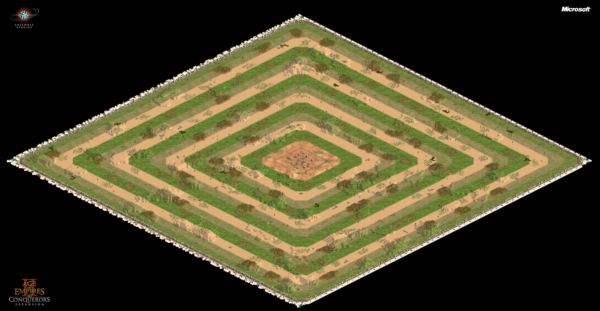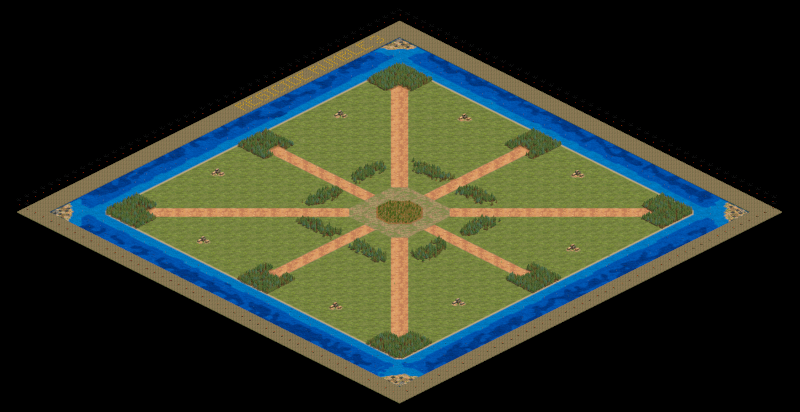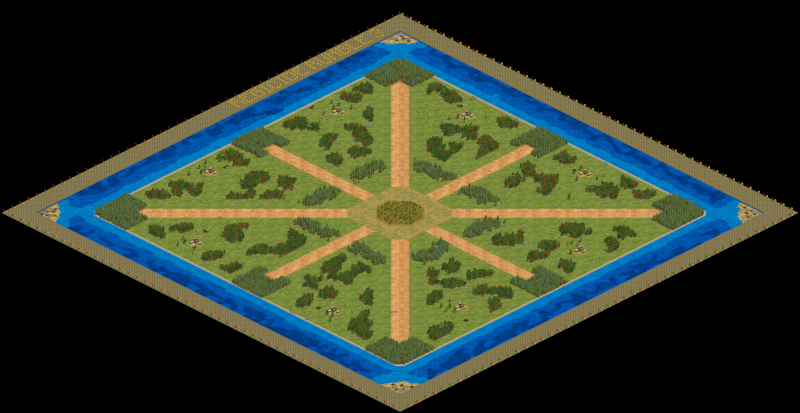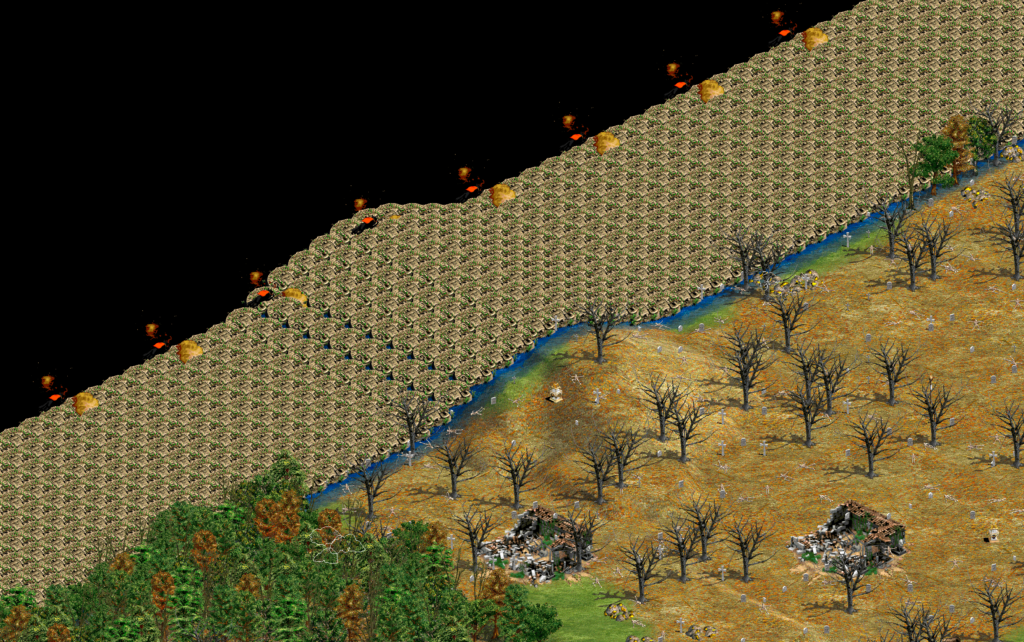Im Januar fanden wieder einmal Studierendenparlamentswahlen statt. Und das Ergebnis war höchst interessant.
Um die Bedeutung des diesjährigen Wahlergebnisses zu verstehen, blicken wir zunächst ein paar Jahre in die Vergangenheit. Damals, man mag es heute kaum glauben, war der Ring Christlich-Demokratischer Studenten (sic), kurz RCDS, noch die stärkste Liste im Studierendenparlament.
In öffentlich zugänglichen Quellen lassen sich die Wahlergebnisse der Studierendenparlamentswahlen seit 2008 nachvollziehen, für die Zeit davor müsste man vermutlich in verstaubte AStA-Archive hinabsteigen. In diesem Artikel soll es vor allem um die Entwicklung der Stimmanteile gehen, daher betrachten wir überwiegend Prozentwerte (gefährlich, ich weiß) statt Sitzzahlen. Das ist gleich doppelt praktisch: Die Verschiebungen im Kräfteverhältnis bei der Abbildung der Stimm- auf Sitzzahlen betreffen uns so nicht. Auch die Verkleinerung des Studierendenparlaments von 51 auf 43 Sitze im Jahr 2013 können wir so ignorieren. Schon zu Beginn des Artikels eine gute Entscheidung! Mega.
Hier sehen wir die Entwicklung der Stimmanteile des RCDS von 2008 bis 2020:
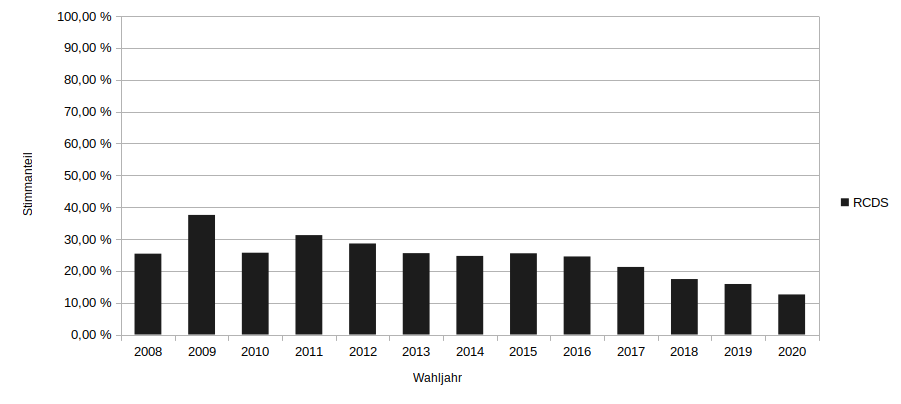
Viele Jahre lag der RCDS stabil um oder über 25 Prozent, was immerhin ein Viertel der abgegebenen Stimmen ausmacht. Seit 2017 geht es aber sanft abwärts. Was ist passiert? Daran, dass der RCDS Wahlplakate mit RAF-Logo aufgehangen und damit möglicherweise seine Stammwählenden vergrault hat, kann es nicht alleine liegen – die gab es schließlich erst im Wahlkampf 2018. Ich bin mir lediglich sicher, dass der RCDS selbst auch gerne eine Antwort auf diese Frage hätte.
Doch bei der Frage, wer die Macht hat im Studierendenparlament, geht es nicht nur um einzelne Listen, sondern auch um Koalitionen. Die einzige RCDS-Koalition des betrachteten Zeitraums, die einen AStA stellen konnte, gab es 2009 zwischen RCDS, der Unabhängigen Liste der Fachschaften (ULF) und der Re(h)-Partei. In der jüngeren Vergangenheit war dann eigentlich die Liberale Hochschulgruppe (LHG) die Liste, mit denen man sich eine RCDS-Koalition am ehesten vorstellen konnte: Der RCDS definiert sich über eine Ablehnung von allem, was “links” ist, beziehungsweise er nennt alles “links”, was er nicht mag; die LHG daneben kennzeichnet ihr Hass auf alles, was “Ideologie” ist, beziehungsweise sie bezeichnet alles als “Ideologie”, was ihr suspekt ist. Super Voraussetzungen also, um gemeinsam gegen die Links-Ideologie zu kämpfen!
Eine zweite Grafik zeigt uns geschwind, wie sich die Stimmanteile der RCDS-Koalitionen über die Jahre entwickelt haben. Dafür stapeln wir einfach die Stimmanteile von ULF, Re(h)-Partei und LHG auf die RCDS-Balken.
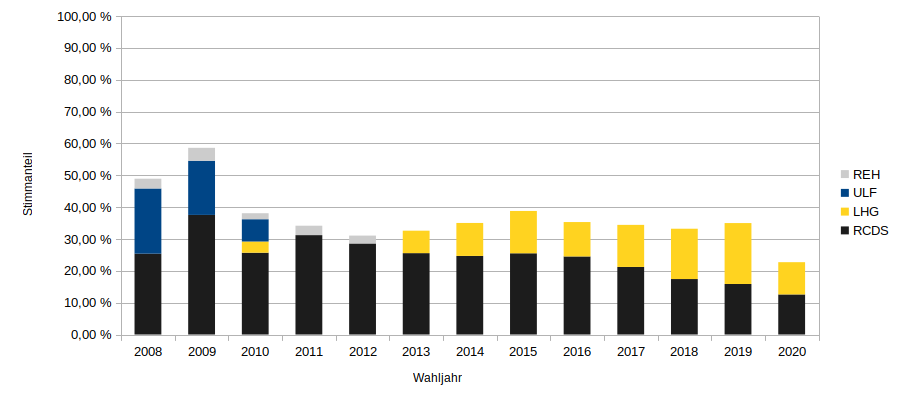
Im Jahr 2009 hat die Koalition aus RCDS, ULF und Re(h)-Partei erwartungsgemäß einen Stimmanteil von über 50 Prozent, was dann auch zu einer Parlamentsmehrheit führt. Im Jahr darauf tritt jedoch einmalig die “Offene Liste der Bildungsproteste (OL:B!)” an, die – man korrigiere mich bitte, wenn ich da falsch liege, das war vor meiner Zeit – ein ähnliches fachschaftsnahes Klientel ansprach wie die Unabhängige Liste der Fachschaften. Die ULF stürzt von 17 auf 7 Prozent ab und ward in den folgenden Jahren nicht mehr gesehen, während die OLB – in diesem Kontext höchst verdächtige – 10,x Prozent holt und danach ebenfalls nicht mehr antritt.
In den folgenden Jahren übernimmt die LHG die Rolle des potenziellen Koalitionspartners, und gemeinsam halten sich die beiden regelmäßig über 30 Prozent. Seit 2017 sieht es so aus, als gebe es da möglicherweise eine Wählendenwanderung vom RCDS zur LHG. Das ist aber reine Spekulation, da die Datenlage nichts besseres hergibt.
2020 dann: Der Absturz. Hatte die LHG noch 2019 den RCDS überholt, was Stimmanteil und Sitze anging, stürzte sie bei der Wahl 2020 von 19 auf 10 Prozent ab – und riss den kombinierten Stimmanteil mit dem RCDS von 35 auf 22,7 Prozent mit sich hinab. Wir erinnern uns: Früher™ holte der RCDS noch mehr als das – und zwar alleine.
Was ist 2020 passiert? Nun, zwei Dinge sind dafür wichtig.
Zunächst: Es gibt zwei Arten von Stimmen – Personenstimmen und Listenstimmen.
- Viele Personenstimmen bekommt man, weil man Kandidierende hat, die viele Leute kennen1.
- Viele Listenstimmen bekommt man, wenn man durch (mutmaßliche) Inhalte überzeugen kann.
Stellt man für RCDS und LHG den Anteil der Listenstimmen an ihrer jeweiligen Gesamtstimmzahl dar, ergibt sich ein klares Bild:
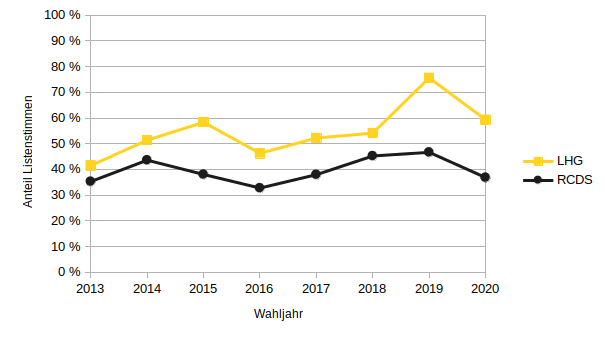
Die LHG wird offenbar stärker wegen ihrer Inhalte gewählt als das beim RCDS der Fall ist.
Prinzipiell ist das gut, weil Inhalte ja prinzipiell gut sind. So läuft man auch weniger Gefahr, plötzlich in der Wählendengunst abzustürzen, weil eine beliebte Kandidatin plötzlich mit dem Studium fertig wird und nicht mehr kandidieren kann.
Der Nachteil dabei ist allerdings auch, dass es passieren kann, dass eine andere Liste bessere Inhalte anbietet, und schwupp landen die Kreuze woanders auf dem Stimmzettel.
Fügen wir der Grafik mal zwei weitere Listen hinzu: Die “Liste Poppelsdorf” (LP) und die Volt-Hochschulgruppe.

Die Liste Poppelsdorf und die Volt-HSG haben sich 2020 ganz neu zur Wahl beworben. Beide Listen haben einen Listenstimmenanteil von knapp über 68 Prozent, wurden also 2020 noch stärker wegen ihrer mutmaßlichen Inhalte gewählt als die LHG. Dass der Anteil der LHG 2020 wieder abfällt spricht für die vorhin skizzierte Wählendenwanderung aus inhaltlichen Gründen: Möglicherweise war das Angebot von LP und VOLT für viele Wahlberechtigte, die 2019 noch ihr Kreuzchen bei der LHG gemacht haben, interessanter?
Die Liste Poppelsdorf ist ohnehin ein hochinteressanter Fall. Sie ist im Betrachtungszeitraum die einzige Liste, die schon im Namen ein örtlich begrenztes Wahlprogramm propagiert: Für den Campus Poppelsdorf.
Man könnte jetzt den Urnenplan teilen: In die Urnen, die auf dem Campus Poppelsdorf stehen, und die Urnen, die dies nicht tun. Und dann mal schauen, was sich bei den “Poppelsdorf-Urnen” in den letzten Jahren so getan hat. Ich schreibe “könnte” – und habe es natürlich getan.
Als “Poppelsdorf-Urnen” zählen wir mal die beiden Urnen der Mensa Poppelsdorf, die MNL, Mathematik, Anatomie, Math.-Nat. 1-3 (Wegelerstraße 10, Geographie, AVZ I), das Hörsaalzentrum Poppelsdorf und die Informatik – auch für die Zeit, in der sie noch in der Römerstraße einquartiert war – und die Wanderurnen Physik / Institut für Geschichtswissenschaft (stand immerhin zu 50 % in Poppelsdorf) und die Wanderurne Poppelsdorf von 2019. Nicht jede dieser Urnen gab es jedes Jahr, aber wir wollen sowieso nur die Summe über alle Urnen in Poppelsdorf betrachten. Wir betrachten die Jahre 2017 – 2020, da wir in diesem Zeitraum den Niedergang des RCDS festgestellt haben und vor allem weil ich irgendwann keine Lust hatte, noch mehr Zahlen abzutippen.
Der Anteil dieser Urnen an der Gesamtstimmzahl bewegt sich in diesen Jahren zwischen 35 und 39 Prozent, außer 2019, da lag er lediglich bei knapp unter 30 Prozent. Betrachten wir nun, wie wichtig diese Urnen für die einzelnen Listen waren, indem wir ihren Anteil an den Stimmen für die Liste berechnen:
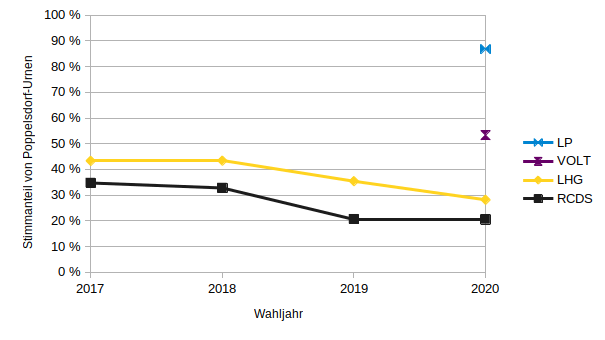
Die Grafik liest sich etwas komplizierter als die vorherigen, daher ein Beispiel: Wären die Stimmen über alle Urnen gleich verteilt, dann hätte jede Liste 2017 ca. 39 Prozent ihrer Stimmen aus Poppelsdorf-Urnen erhalten, da 2017 ca. 39 Prozent aller Stimmzettel aus Poppelsdorf-Urnen kamen. Der RCDS hat 2017 aber etwas weniger als 35 Prozent seiner Stimmen aus Poppelsdorf-Urnen erhalten. Bei der LHG hingegen kamen im gleichen Jahr ca. 43 Prozent ihrer Stimmen aus Poppelsdorf-Urnen. Das bedeutet, dass man im Vergleich zur Gesamtwählendenschaft in Poppelsdorf stärker empfänglich für LHG-Wahlkampf als für RCDS-Botschaften, in welcher Form auch immer, ist.
Der Einbruch bei LHG und RCDS im Jahr 2019 geht damit einher, dass lediglich 30 Prozent aller Stimmen aus diesen Poppelsdorf-Urnen kamen, lässt sich also teilweise damit erklären.
Doch dann kommt 2020. Der Anteil der Poppelsdorf-Urnen an den Gesamtstimmen steigt wieder auf 37 Prozent. Man würde also prinzipiell erwarten, dass die Anteile von RCDS und LHG wieder auf das Niveau von 2018 steigen. Doch das ist nicht der Fall: Der Anteil der RCDS-Stimmen stagniert, der Anteil der LHG-Stimmen sinkt weiter ab.
In diesem Jahr kommen jedoch zwei neue Listen hinzu, die in Poppelsdorf offenbar starken Anklang finden. Die Volt-HSG bezieht über die Hälfte ihrer Stimmen aus Poppelsdorf-Urnen, was recht viel ist. Aber das ist noch wenig im Vergleich zu den 86,8 Prozent der Liste Poppelsdorf!2 Wir haben hier ganz klar das Muster einer Regionalpartei.
Ändern wir einmal mehr den Betrachtungswinkel. Eben haben wir gesehen, dass Poppelsdorf ein wichtiges Gebiet für die Liste Poppelsdorf zu sein scheint. Doch wie stark ist die Liste Poppelsdorf in Poppelsdorf? Stellt sich heraus: Sehr stark. Wir betrachten die Stimmanteile aller Listen, nur bezogen auf die Poppelsdorf-Urnen:
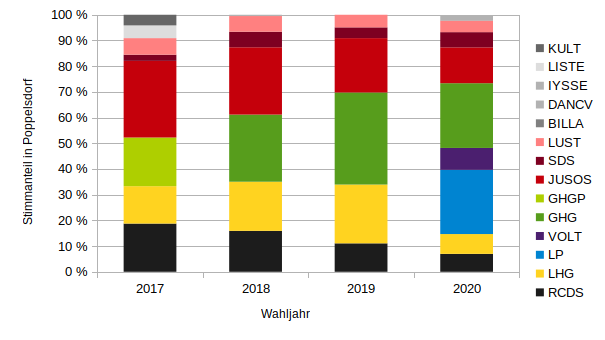
Die Liste Poppelsdorf holt 2020 an den Poppelsdorf-Urnen aus dem Stand 25 Prozent aller Stimmen. Das sind die zweitmeisten Stimmen an den Poppelsdorf-Urnen hinter der GHG, die dort lediglich vier Stimmen mehr bekommen hat. Nimmt man die Chemie-Urne noch dazu, herrscht sogar Gleichstand zwischen GHG und LP. Absolut beeindruckend.
Betrachtet man die obige Grafik, sieht es aus, als haben VOLT und LP fast allen Listen Stimmanteile abgenommen. Die LHG allerdings wurde geradezu dezimiert. Da werden bestimmt einige Stimmen von der LHG zur LP gewandert sein.
Meine Vermutung: Die mathematisch-naturwissenschaftlichen Studierenden haben sich gefreut, dass endlich eine Liste den W-Lan-Ausbau an der Universität fordert, die nicht diesen ganzen nervigen Ideologie-Kram dabei stehen hat. Oder lag es an peinlichen LHG-Slogans wie “Du wolltest schon immer mal mit deinem Prof ins Bett?” Wer weiß das schon.
Die Frage für RCDS und LHG müsste nun lauten: Sind LP und VOLT passende potenzielle Koalitionspartnerinnen, die ihre Stimmverluste kompensieren können?
Mein Tipp, wenn ich mir deren Personal so ansehe, lautet ja: Nö.
Rohdaten (ods-Datei)




